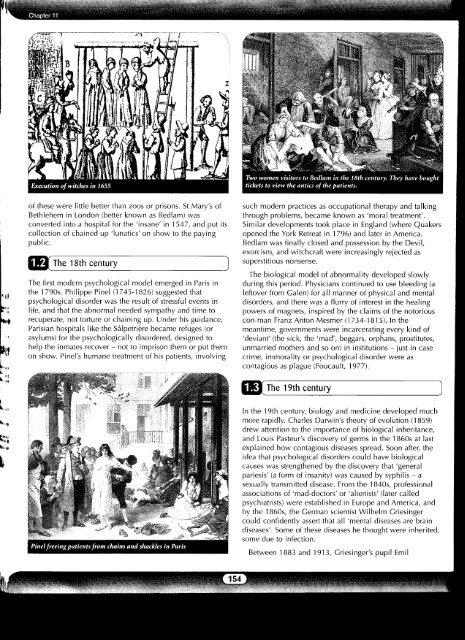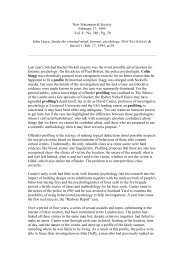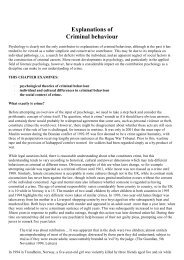Ch 11 - Jeff Standen
Ch 11 - Jeff Standen
Ch 11 - Jeff Standen
Create successful ePaper yourself
Turn your PDF publications into a flip-book with our unique Google optimized e-Paper software.
of these were little better than zoos or prisons. St Mary's of<br />
Bethlehem in London (better known as Bedlam) was<br />
converted into a hospital for the 'insane' in 1547, and put its<br />
collection of chained up 'lunatics' on show to the paying<br />
public.<br />
The 18th century<br />
'<br />
The first modern psychological model emerged in Paris in<br />
the 1790s. Philippe Pinel (1745-1826) suggested that<br />
psychological disorder was the result of stressful events in<br />
life, and that the abnormal needed sympathy and time to<br />
recuperate, not torture or chaining up. Under his guidance,<br />
Parisian hospitals like the Salpetriere became refuges (or<br />
asylums) for the psychologically disordered, designed to<br />
help the inmates recover - not to imprison them or put them<br />
on show. Pinel's humane treatment of his patients, involving<br />
such modern practices as occupational therapy and talking<br />
through problems, became known as 'moral treatment'.<br />
Similar developments took place in England (where Quakers<br />
opened the York Retreat in 1 796) and later in America.<br />
Bedlam was finally closed and possession by the Devil,<br />
exorcism, and witchcraft were increasingly rejected as<br />
superstitious nonsense.<br />
The biological model of abnormality developed slowly<br />
during this period. Physicians continued to use bleeding (a<br />
leftover from Galen) for all manner of physical and mental<br />
disorders, and there was a flurry of interest in the healing<br />
powers of magnets, inspired by the claims of the notorious<br />
con-man Franz Anton Mesmer (1734-1815). In the<br />
meantime, governments were incarcerating every kind of<br />
'deviant' (the sick, the 'mad', beggars, orphans, prostitutes,<br />
unmarried mothers and so on) in institutions - just in case<br />
crime, immorality or psychological disorder were as<br />
contagious as plague (Foucault, 1977).<br />
The 19th<br />
Pinel freeing patients from chains and shackles in Paris<br />
In the 19th century, biology and medicine developed much<br />
more rapidly. <strong>Ch</strong>arles Darwin's theory of evolution (1859)<br />
drew attention to the importance of biological inheritance,<br />
and Louis Pasteur's discovery of germs in the 1860s at last<br />
explained how contagious diseases spread. Soon after, the<br />
idea that psychological disorders could have biological<br />
causes was strengthened by the discovery that 'general<br />
pariesis' (a form of insanity) was caused by syphilis - a<br />
sexually transmitted disease. From the 1840s, professional<br />
associations of 'mad-doctors' or 'alienists' (later called<br />
psychiatrists) were established in Europe and America, and<br />
by the 1860s, the German scientist Wilhelm Griesinger<br />
could confidently assert that all 'mental diseases are brain<br />
diseases'. Some of these diseases he thought were inherited,<br />
some due to infection.<br />
Between 1883 and 1913, Griesinger's pupil Emil







